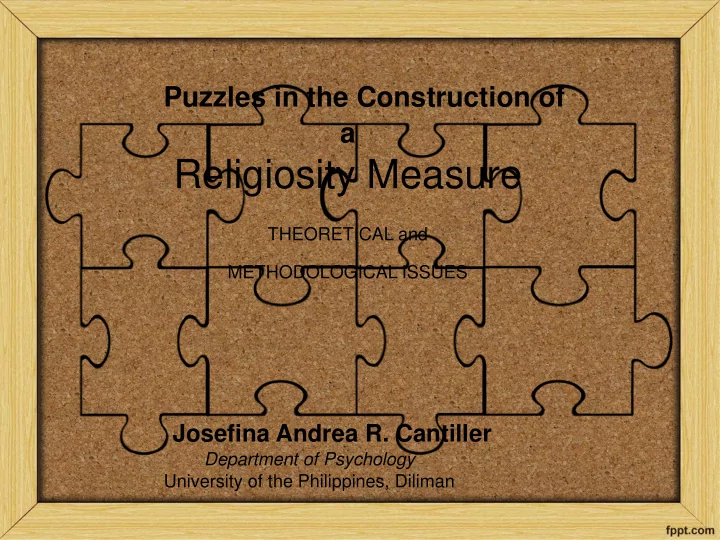

Puzzles in the Construction of a Religiosity Measure THEORETICAL and METHODOLOGICAL ISSUES Josefina Andrea R. Cantiller Department of Psychology University of the Philippines, Diliman
Discuss theoretical & methodological issues related to the construction of a scale to measure the psychological construct of Religiosity as applied to a Filipino setting.
Four Puzzles A. Is religiosity the same as spirituality? B. What is the appropriate method for examining an abstract concept such as religiosity? C. What dimensions make up Filipino religiosity? D. Is religiosity as a psychological construct better understood as being uni-dimensional or multi-dimensional?
THEORETICAL ISSUES Religiosity or Spirituality? Multidimensional or Unidimensional?
What is RELIGIOSITY?
Religiosity/Religiousness » Has specific behavioural. social, doctrinal, & denominational characteristics because it involves a system of worship & doctrine that is shared with a group (Mokua, Hishinuma, & Nishimura, 2001)
Spirituality (Mokua, Hishinuma, &Nishimura, 2001) » Concerned with the transcendent, addressing ultimate questions about life’s meaning » Can exist within & outside the context of religious doctrine & institutions » Encompasses such realms as the cognitive or philosophic, the experiential and emotional, and the behavioral (Anandarajah and Hight, 2001)
Zwingmann, Klein, & Bussing, 2011 System of beliefs & practices Religiosity transcendence experience Spirituality existential (meaning/purpose) secular Spiritual but not religious humanism
METHODOLOGICAL ISSUES How do we measure RELIGIOSITY?
REPRESENTATIVE VIEWS (Chen & Chen, 2012) Scientific Empiricism Post-modern standpoint Problem-oriented
Scientific Empiricism Objectivism vs. Subjectivism (Wulff , 1991, 1997) Experimental Method (Barrett ,2004, 2008)
Methodological pluralism (Slife and Gantt,1999 and Slife and Melling, 2012) Value of qualitative vs. quantitative research (Nelson 2009, 2010) Post-modern Standpoint
Chen, et al (2005) Relevant philosophical Problem-Oriented foundation + specific research issue Diversification Integration
Procedure for developing scale » Dimensions were conceptually derived » Qualitative (interviews, pakikipagkwentuhan) » Quantitative (survey, scales) » Item pool to Scale construction » Data Analysis » Qualitative: Thematic Analysis » Quantitative: Validity & Reliability studies
Panukat ng Pagkarelihiyoso * Items written in Filipino * 111 items (1990); 95 items (2008) * 5-point Likert Scale * Item mean : 3.62 * Range of item means : 2.4 to 4.5 * Inter-item correlation mean : 0.23 * Range of Significant correlation coefficient s: -.27 to .76 * Most items are “moderately to highly intercorrelated”
Internal Consistency Reliability (Cronbach’s alpha values) Dimensions 1990 sample 2008 sample KAPWA .72 .74 RITWAL .86 .90 PANINIWALA .85 .85 SIMBAHAN .87 .79 DIYOS .89 .92 BUNGA .79 .81 Pagkarelihiyoso .964 .97
7 Dimensions of Pagkarelihiyoso *Kaugnayan sa Kapwa- mananampalataya *Pananalig sa mga Paniniwala *Paglahok sa mga Ritwal *Pagpapahalaga ng Simbahan *Kaugnayan sa Diyos *Bunga ng Relihiyon *Kaalaman tungkol sa doktrina
Pagkarelihiyoso ( Cantiller, 1990, 2008 ) A comprehensive term used to refer to the numerous aspects of religious activity, dedication, & belief . “ Ito ay may kinalaman sa antas ng pagtanggap ng tao sa mga doktrina, ang kanyang paglahok sa mga ritwal sa loob ng isang institusyon/kilusan at pagpapamalas ng mga paniniwalang ito kaugnay ng kanyang kapwa at ng isang Supernatural na nilalang .”
Ang Pilipinong Kristiyano na relihiyoso ay may pagpapahalaga sa KAUGNAYAN SA DIYOS Siya ay … * Lumalahok sa mga ritwal * Sumusunod sa utos ng simbahan * Ginagampanan ang mga relihiyosong obligasyon
Is Religiosity a Multidimensional or Unidimensional construct?
Religiosity Scales Lenski’s four dimensions (Lenski 1961) Glock’s five dimensional typology (Fukuyama, 1961; Glock and Stark, 1965; Faulkner and DeJong 1966) Allport’s intrinsic -extrinsic typology (Wilson, 1960; Feagin ,1964; Allport and Ross, 1967). Mataragnon (1984) Cantiller (1990, 2008)
» PAGKARELIHIYOSO SIMBAHAN KAPWA RITWAL PANINIWALA ? BUNGA DIYOS DOKTRINA
3 General Components » Dimensions are theoretically derived by 3 general components: » religious belief » commitment » behavior But… Panukat ng Pagkareliyoso was constructed using a bottom-up approach!
DIMENSIONS Belief Commitment Behaviour & Participatio n Kaugnayan sa Kapwa- X mananampalataya Pananalig sa mga Paniniwala X Paglahok sa mga Ritwal X Pagpapahalaga ng Simbahan X Kaugnayan sa Diyos X Bunga ng Relihiyon X Kaalaman tungkol sa doktrina X
Religiosity is Multidimensional BUT … Variation in the content and number of reported dimensions appears to be the product of: * different approaches to defining & measuring relevant dimensions * different analytical methods * different populations examined
The Peripheral Dimensions of Religiosity (Duke, 1998) (1) communal involvement or congregational friendships (2) the intellectual or knowledge dimension These dimensions have been excluded (3) the experiential or religious because they can be conceptualized as experience dimension either an antecedent or a consequence of (4) the consequential dimension . religiosity, but are not indicators of religiosity per se (Cornwall 1985).
» PAGKARELIHIYOSO X SIMBAHAN KAPWA RITWAL PANINIWALA X X ? BUNGA DIYOS DOKTRINA
Is it Unidimensional? Exploratory Factor Analysis results show similar loadings of 86 items in one factor Exploratory Factor Analysis results show similar loadings of 86 items in Certain items are highly loaded in other factors but numbers are smaller one factor Certain items are highly loaded in other factors but numbers are smaller
Is it Unidimensional? * “Loyalty to church and Dependence on God” - 4 items. * “Manifestations of Faith” - 10 items. * “Importance of Institutional church” - 5 items. * The rest of the factors - 2 or 1 item/s with Abangan ang susunod na high loadings. kabanata… »
REALIZATIONS » Quantitative & qualitative methods are necessary tools to understand religiosity » Culture is a factor in determining the meanings of religiosity » Application to all religions is limited » Different beliefs » Different terms for practices
M
Recommend
More recommend